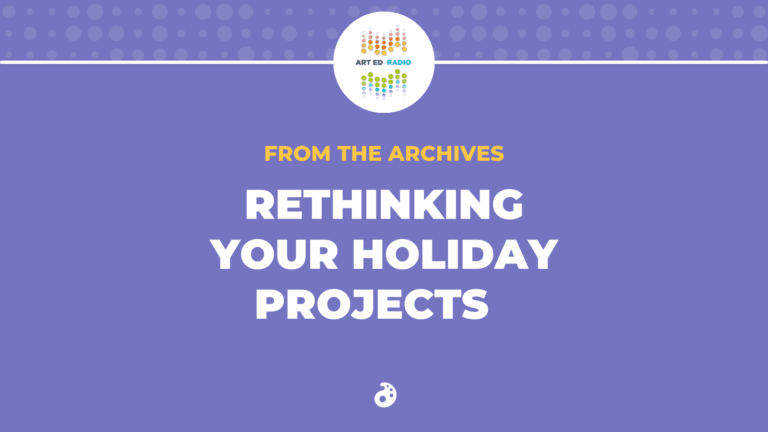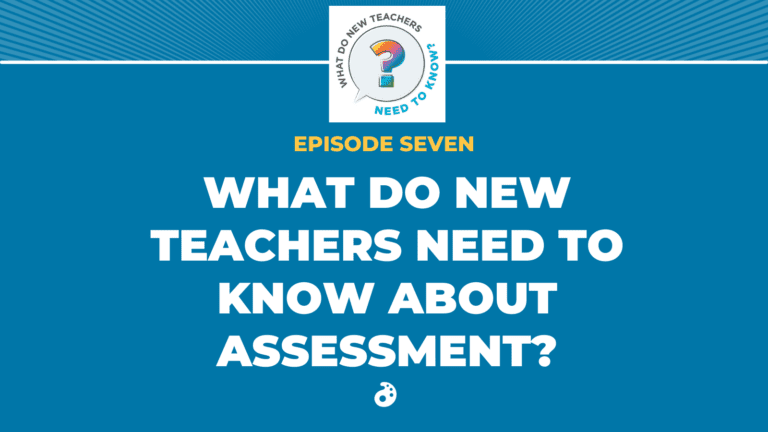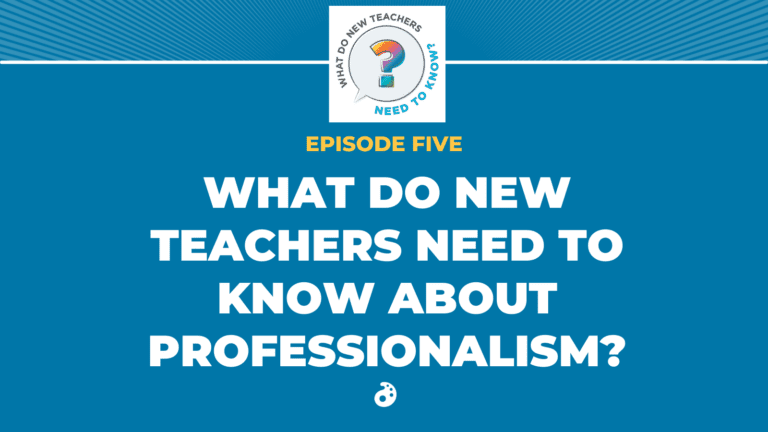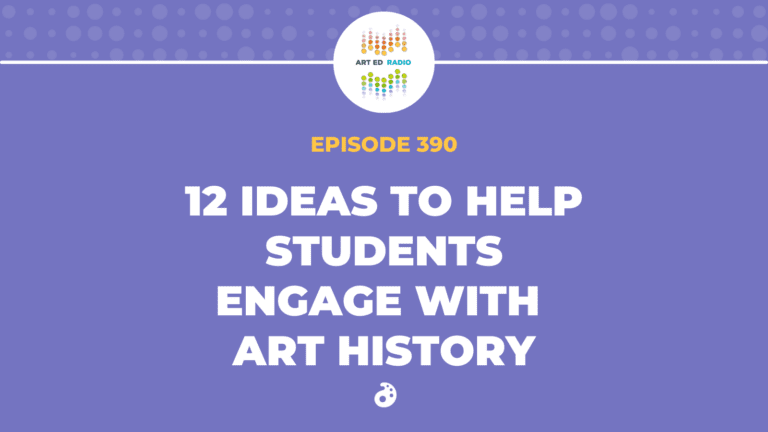Today is the fourth and final episode in a series of Everyday Art Room podcasts that explore the national standards. Today, Nic gets a variety of voices to come on the show to talk about the Present standard. Listen as they discuss how students can meet the Present standard, how they can curate an art space, and the importance of sharing with peers, teachers, and the community at large. Full Episode Transcript Below.
Resources and Links
- Follow Ann, Polly, and Michelle on Instagram
- View the NCCAS Conceptual Framework
- NCAS Visual Art Standards At-A-Glance
- View the PRO Learning Pack on Implementing the National Standards
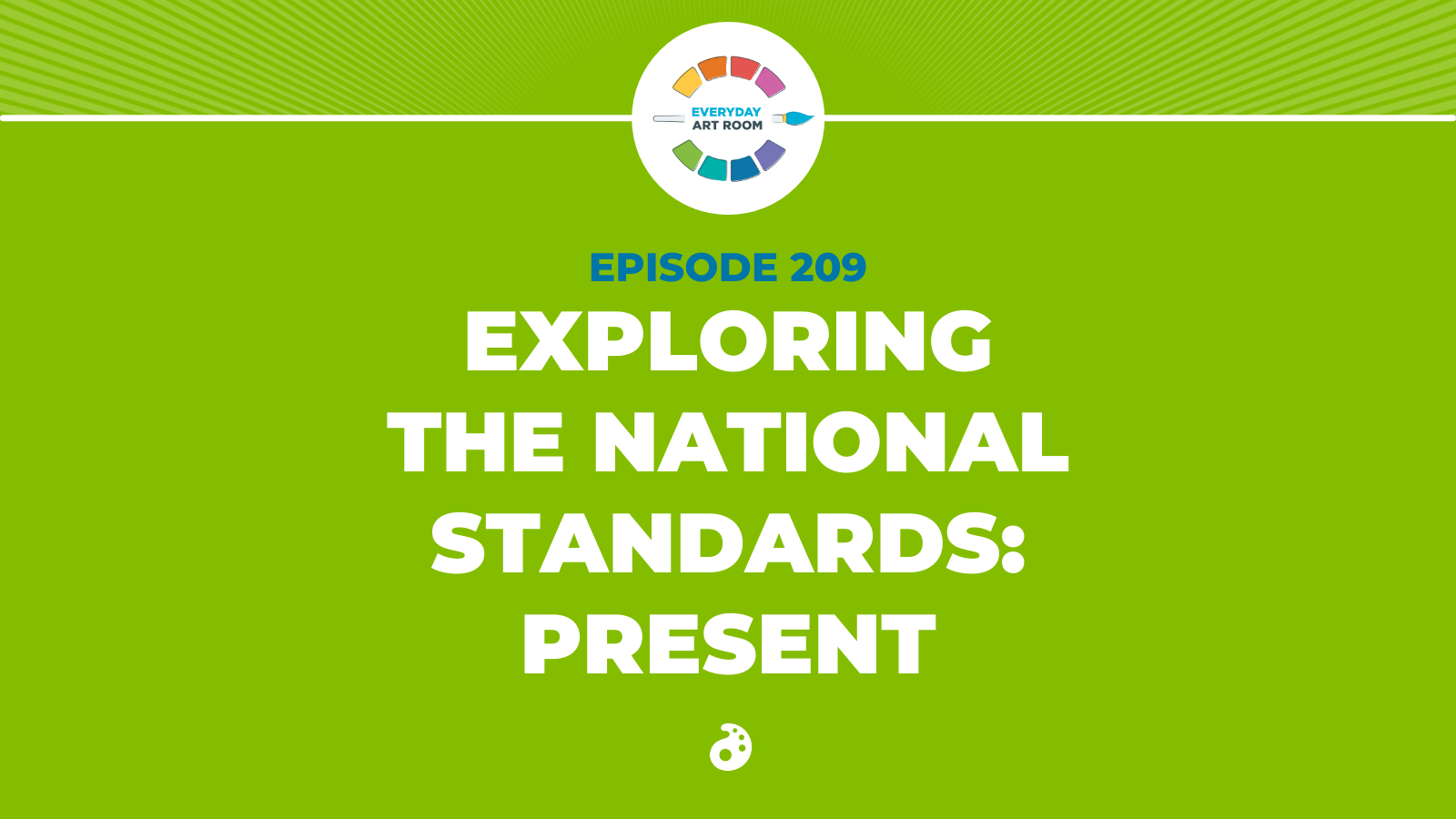
Transcript
Nic: Welcome back to Everyday Art Room. The last couple of weeks, we have been talking about the Visual Arts National Standards. Recently, let’s see, two, three weeks ago. I don’t know, it’s been a while here. We talked with Janet Taylor who kind of laid down the groundwork for what the National Standards are all about. And then we decided to tackle each of the more difficult standards. So two weeks ago, we talked about respond ,and then last week we talked about connect, and today we’re going to be addressing the National Core Standard of present. This is Everyday Art Room, and I’m your host Nic Hahn.
If you’ve listened the last couple of weeks, you know that this conversation actually began on Instagram by Anne who reached out to me on a private message asking me about the National Standards. I quickly realized that this was going to be too big of a conversation to have over Instagram, so we decided to make not one or two or three, but four podcasts on the subject.
And we have also brought in multiple voices to get ideas of what other people are doing in their classroom right now today to address the National Standards. I’m going to let Anne first introduce herself to us. She’s the person who connected with me via Instagram.
Anne: Hi, my name is Anne Canida, and this is my 10th year teaching kindergarten through sixth grade art at Central Lee Community School District in Donnellson, Iowa. Previously, I taught a gamut of different things. Some first through fifth grade art. I was a reading specialist. I also taught at a, and ran before and after school program. I was the middle school coordinator. So it took me a little bit to get to my dream job.
Nic: In our conversation on Instagram between Anna and I, we were actually talking mostly about the big shift in 2014, where the National Standards were very clear cut. You could check them off, they were very like teach the students line, teach them color. And they moved into something that was a little bit more abstract.
Anne: Going from the very specific state standards to more of the open-ended National Art Standards, it’s become a little, frankly overwhelming, and I’m questioning whether or not I’m interpreting them correctly. Am I using them to their fullest? With me being a singleton in my school district, I don’t have that immediate constant network of teachers next door or in the neighboring building where we can really get together and compare and contrast and look at how we’re introducing those, how we’re interpreting them to know whether or not I’m truly teaching the standard correctly, or using it in its best way.
Nic: And that is why, right there, did you hear Anne say she was a singleton in her building? I think a lot of us can relate to that. Even if there is a coworker in the building, it doesn’t mean that there’s someone who really wants to dive deep into discussing these National Standards. So that is why we decided to make this podcast, is to really, if you want to dive deep into this and you want real-life examples, this is exactly where you should be today.
Let’s hear what Anne was specifically thinking when she was asking about presenting.
Anne: In looking at presenting, do you look at that as opportunities for students to show their work in class for more of a class critique? Are they displaying it for others in the building to see? Are you looking at it more as presenting, as opportunities for students to think about where can art be created, or where can it be displayed?
Nic: We are going to hear from a couple of different voices. The first voice is someone I admire very, very much. Polly Blair is going to share her ideas of how she uses the idea of present in her classroom.
Polly: Hi, my name is Polly Blair. I am an elementary art educator in Overland Park, Kansas. I have about 520 young artists that I work with. And I’m also a museum educator at the Nerman Museum of Contemporary Art in Overland Park. I run a tab classroom with my second through fifth graders. And even with my littlest kiddos, my kinder and first graders, I try to talk about the standard of presenting in different ways.
I like to bring the idea of curators from a museum standpoint. I like to talk about how a curator is somebody who helps choose artwork. And so one thing I will do, is I will have my students work collaboratively with a set of art postcards to identify images that they would like in a museum or a museum gallery based on a theme. It could be a principle or element of art, or even a big idea theme like identity.
In other years, I’ve assembled a three-sided, well sort of a three-sided cube. And I’ve had students make miniature art museums decorating the size and the floor of those little cubes. And they’ve figured out what they want in their little miniature museums.
For my older kiddos, they also have a chance to self-select artwork to be hung on the halls. And I will make sure that they have an artist statement that goes with their art if they choose to hang them in the hallway.
So by having students identify things that can be presented together in a theme, identifying images or art that they’ve made that they would like to go hang in a hallway, and then have those things accompanying an artist statement, those are some of the ways that we use presenting in the art room at my school.
Nic: Perfect. I love the idea that Polly has this background of not only being an art educator, but also being a museum educator. And I think that brings her brain to a different place, right? We all have these different experiences, and that is why we’re going to all be addressing each of these standards a little bit unique from each other. But this idea of having the kids curate a space, or even if it’s a little tiny mini space, or coming up with a theme and having students choose what postcards they would put into their theme, that is a really great way to have students interact.
And I also like, I mean, you could do this in large group or small group, depending on the resources that you have. And then having students explain, why did you put these together? What is the purpose? What unites these? That is an incredibly interesting idea to have our students become curators.
Now let’s shift from what Polly had to share with us, and we’re going to go into Michelle Miller who’s going to talk to us a little bit about her tab classroom. She has 20 years under her belt or more, and she is running the tab classroom and addressing all of these National Standards. But she’s going to talk to us today about presenting.
Michelle: Hi, my name is Michelle Miller. I have been teaching elementary art for over 20 years now. I currently work in Germantown, Maryland. And for the past eight to 10 years, I have been doing choice-based art education and teaching for artistic behavior. I like how the choice naturally connects to our National Art Standards and the artistic process.
The best way I have my students present their work is at the end of class. After cleanup, we get in a circle and the students are able to share what they’re working on. They talk about their project, their materials, their ideas. It’s a great time to get feedback from their peers, and lots of inspiration and motivation happens during our share time.
Sometimes we don’t have enough time to do a whole class share so we’ll do a table share or a peer share depending on our time. The students really like sharing their artwork and talking about what they made, so it makes cleanup go a little bit faster so we can get to the sharing.
I even have a share chair that the kids can sit on. It’s a lot of fun. But again, if you don’t have enough time for a whole class, you could do a table share where students are sitting around the table that they were working at and they just share with each other.
Another way I have my students present is a hallway display. So if students feel more comfortable hanging their work up instead of talking in front of their peers, they can choose that option. If they choose the hallway presentation, they have to mount their artwork and write an artist statement that goes with their artwork. And then the both are displayed in the hallway. That is another great way to present.
Thanks so much for letting me share how my students present their artwork.
Nic: Michelle had some great ideas as well, and simple, just really, really simple. Just allow your students the time to share. Now, we could become a very product-driven group of people, right? I mean, we only have the kids for this long and we want to make sure that they create making this and using this. And we want to make sure that they’ve learned this artist and that artist, and this concept. And it’s a lot to take in. But sometimes, sometimes we need to slow. We need to calm. And allowing time for students to share and celebrate with each other, is absolutely something that will be very rewarding in any classroom.
I like how Michelle gave us some different ideas too, of what sharing can look like. It can be sitting in that share chair, which, come on, now, that’s awesome. A share chair. Sitting in that share chair and presenting to an entire group. But bringing it down, maybe you don’t have enough time, maybe cleanup took longer than you expected. Having them share to their table. Having them share with a peer, maybe someone that they admire or respect in their classroom. That is a really good way to just have students actually present their artwork to someone else, not just to the teacher and not in the hallways, but talking to someone and telling them what they were thinking when they were creating.
But moving on to her idea of actually presenting it in the hallway. I don’t know if Michelle had actually done this in this way, but it sounds like you could almost give that as a reward system. Like, once you have created your art and you have your artist statement to go with your art, you have the honor of hanging it in the hallway. So, that might be another way to really highlight this idea of presenting visual arts. Artists often want to share their art in a public space. Here’s the public space, and here’s how you’re going to earn your right to do this.
And some students are going to say, “No, I really don’t feel comfortable having my artwork up there.” And that’s okay too. So then come up with an alternative. Are they going to share it to their parents? And let’s get into that. So after listening to Ms. Polly Blair And Ms. Michelle Miller, thank you very much for presenting today, presenting your presenting, I guess so. I think that prompted some of the ideas and ways that I like to present in my classroom.
Again, I’m working currently as a kindergarten through fifth-grade teacher, but I have worked in the middle school up to eighth grade for a lot of my career. I did work in high school for a period of time, but really that was at the beginning of my teaching, and so these standards didn’t even exist because it was what? 2002, 2003. Wow, I’m dating myself.
But more importantly, I’m going to talk to you about how I have my students present all the way down from kindergarten, all the way up to eighth grade. But I think you can… If you open your brain up to what I’m saying, or what Polly Blair has said, or Michelle Miller, you’re going to be able to implement some of these things in your classroom, even if you’re working in the high school.
So one of my favorite ways to present is using an app called Seesaw, and I’ve talked about this app on the podcast before. Many of you know, this is an educational tool that many, many schools use. What I love about Seesaw is the ease in what it is used.
So in my school, it’s an app that we use for kindergarten through second grade. And you can use it in a variety of ways. So sometimes what I’m doing is presenting to parents what’s happening in the classroom. It’s kind of an arts advocacy way to use Seesaw. So I will… I should even explain this.
So Seesaw, it’s like a personal Facebook page for parents, basically. I can post something onto Seesaw and it immediately gives the parents a notification. “Hey, Ms. Han has just posted something. Take a look, see what is being shared with you.” So you can communicate with parents with like, “Hey, on this day, we’re going to be using Play-Doh. If anyone would like to donate some Play-Doh, I’d much appreciate it.” Or I might go around the classroom and use it as arts advocacy. So I might say, “Today we are working on painting and I’m just walking around the room,” and I have my headphones in so that it can be heard very clearly, what I’m talking about.
“Today, your students are learning about color. When they come home today, you’re going to ask them these three questions. What makes orange? What makes purple? What makes green? This is how we’re doing it. We’ve been mixing our paints with our fingers, and it was just a lot of fun. P.S., sorry, if there’s any mess on the shirt.” Send that out to all the parents. Now I’ve done a couple of things. I’ve told them the excitement that we had in classroom. Parents have the opportunity to quiz their student when they get home, and that’s going to create deeper understanding of the content that we covered. And then also, it’s just arts advocacy. Every day your student comes here, we have joy and we create. How amazing.
But I use this often for presenting. I have students… We have to work our way up to this. So kindergarten. Kindergarten, I’m concentrating on having students take a picture of their art and sharing it with mom and dad. That’s pretty much the only… The only goal for me in kindergarten is starting to have students learn how to use this iPad, learn how to use this app, to make sure that their parents are seeing the art that they’re creating in class.
It takes a year, and this is also happening in their classroom, so they’re having double practice. They go to media center, so they’re having practice up there as well. It’s being used in music, it’s being used in phy-ed. But in art class, that’s my main objective. By first grade, we’re starting to explore a lot more because the students have the skills. They’ve learned how to use the tool, and now we’re going to make deeper meaning of this.
So in first and second grade, I’m asking my students to take a picture of their art at the end. And this usually is a whole lesson in itself. So they take a photograph, and then we’re going to do a little prompt. I might ask them to explain the process of their art. And of course, I would use student-friendly language for that. I might have them explain what the meaning is behind their art. What’s happening in their art. I might have them do a little reflection of what they think it turned out like. Was it exactly what they had planned? Are they happy with it? What would they do if they made it again? What would they change?
It depends on what I’m seeking in the lesson as to what the prompts are. But my students have the opportunity to think about those prompts. In second grade, we’re writing down exactly what we’re going to say. So they’re creating a script or an artist’s statement that they’re going to be telling their parents. We find a quiet space in the room, which is impossible, right? That doesn’t happen. There’s no quiet space in the classroom. So instead, I have the students plug in their headphones, and in my art classroom, I have headphones that have a microphone to their sweet little voice. They plug that into their iPads and they take a photograph of their art.
On the second step of Seesaw, they’re able to do a couple of things. They can write using words, texting, using some words. They can also record, and that’s what I have them do. So they record with the image. And during this time, they can actually use markers, digital markers to circle, to point, to address any area that they might be talking about in their artwork. But they’re not actually destroying their artwork, they’re highlighting the different areas that they’re talking about when they’re talking about them to their parents.
After they hit the checkmark and I approve their work, this goes directly into the hands of their parents, or pockets, wherever they’re keeping their phone, right? Immediately when we approve that post, their parents get to see their child present their artwork. So if that piece of artwork never actually makes its way home, maybe it got shoved in the backpack or lost somewhere along the way, it’s okay because their parents have already seen the image.
But more importantly, they have documentation of the sweet little first-grade voice talking about their art. This can be downloaded and saved, or it can just be an experience the parents get to see in person. These are the things that we as art educators get to see in person, real life all the time, but how powerful to have our stakeholders, our parents, the people that support us, actually hear their students talk about the same things as well.
Now in the middle school, I did a similar activity. We would often… Okay. So when I was teaching in the middle school, most recently, it was four years ago. And so our main way of communicating with parents at that time was to email them. So three times a week or… Three times a week, no, that would be a lie. Three times a quarter, I would have the students sit down and draft an email and I would be CC’d on it. So this email would have prompts as well.
You’re going to tell you your parents first, what you are doing in art class right now. So what are you making? What are you learning? What mediums are you using? What was hard? What was fun? What was difficult? You’re going to send them a high-quality picture of your art. Whatever was your most recent artwork, or maybe multiple images. It can be the process of what you were doing, or it can be the final product. And then, well, I mean, I do get this in, if you’re missing any artwork, you’re going to be explaining that to your parents at this time. And then you’re going to thank your parents for anything that you want to. Tell them what an amazing cook they were in the meal that they made you the night before. Tell them thank you to bringing you to all of your activities.
And then sometimes I ask them, you might want to consider putting in, “And I also just really love Dairy Queen treats, so thanks for knowing that about me, mom, dad, parent, guardian,” whoever this email is going to. You know what? I’ve had multiple students tell me that they’ve gotten some Dairy Queen off from an email in the middle of the day. I’m telling you as a mother of an eighth-grader, an email from your child telling you what’s happening in their life, as well as what they appreciate about you, yeah, guess what? You’re going to go buy them some ice cream. That was a great gift that they gave you in the day because that conversation doesn’t always necessarily happen in the household.
I also was CC’d on those emails, or now I think I was CC’d rather than blind copied. That is how I was able to just give a little qualification of what they are presenting, so it was also a formative/maybe a summative assessment on what kind of content they were able to tell their parents in the prompts that I had requested.
So this is a great way to have parent-student communication. It means so much more when it’s coming from the student, when the student is saying, “I’m making this art, and this is what I’m learning.” That is excellent training for our students to be able to converse with another person and tell them what they were thinking when they were creating their art. That is two ways, I guess Seesaw and emails, of ways that I used present in my classroom. And I found them to be extremely authentic.
There we have it, going out with a bang. We have fully covered the National Standards, starting out with just kind of an overview and then really addressing what I find the most difficult, respond, connect. And then today we talked about presenting. We didn’t actually talk about creating in a separate podcast, a special podcast, because I truly feel like most of our conversations as visual art teachers, is revolving around the create. That’s the easiest one for us. We know how to do that. We use other resources, such as the magazine on The Art of Education university’s website. That’s going to have plenty of ways to create, okay?
We go to our social media, we go to Facebook, we go to Instagram, we go to TikTok to find out ways to create. But I think this deeper thinking of presenting and connecting and responding, this takes a conversation, and I’m so grateful to everyone who donated their time and their voice and their thoughts to the podcast series that we are now wrapping up.
So tune in next time, we will be talking about something new. I’ll see you then.
Magazine articles and podcasts are opinions of professional education contributors and do not necessarily represent the position of the Art of Education University (AOEU) or its academic offerings. Contributors use terms in the way they are most often talked about in the scope of their educational experiences.
